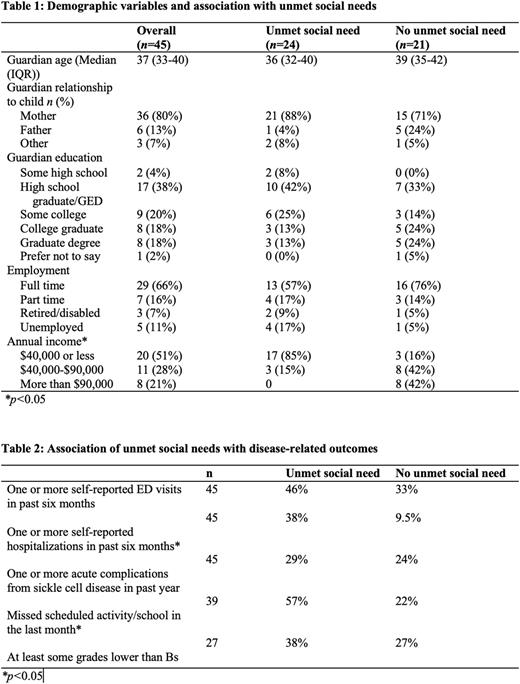Abstract
Background: Social Determinants of Health (SDoH) are socioeconomic factors that influence health and well-being and are largely responsible for health inequities. Research has shown that economic, housing, food and medical insecurities are associated with lower quality of life, poor mental health, and worse outcomes for people living with chronic illness. Individuals with Sickle Cell Disease (SCD) are at increased risk of mortality, poor health-related quality of life, functional disability and high health care utilization. Furthermore, SCD primarily affects populations of African descent, who also tend to be disproportionately burdened by poverty and systemic racism. Prior studies have shown that children with SCD from lower income families have worse health-related quality of life, and higher healthcare utilization rates. However, there is paucity of data investigating links between SDoHs with quality of life and disease-related outcomes in this population. Thus, it is important to gain a better understanding of how these factors affect the well-being of children living with SCD. In this study, we attempt to identify the unmet social needs of patients in one pediatric sickle cell clinic and their association with self-reported health care utilization and disease complications.
Methods: We approached pediatric patients (aged 1-18 years) and their guardians attending routine visits at the Children's Hospital of Richmond Comprehensive Sickle Cell Clinic. Those coming for a newborn visit or having acute crises were excluded. After consenting, parents completed a demographic and patient-reported outcome questionnaire followed by the Boston Medical Center's WECARE survey that screens for SDoH, such as housing, food, utility, transportation and medical insecurities. We defined an unmet social need as any positive answer to the WECARE survey. Counts, percentages and exact tests were used to examine the relationship between unmet needs and demographic factors and disease outcome variables.
Results: To date, 50 children with SCD aged 1-17 years and their parents were screened, consented, assented (children >7) and completed the surveys. There was incomplete data on social needs from 5 subjects, thus 45 total are included here. 53% of subjects indicated an unmet need in at least one of the categories in the WECARE survey: 41% had food insecurity, 4% had housing insecurity, 13% had problems paying for medication, 11% had problems with transportation, 24% had trouble paying utility bills, 9% had difficulty taking care of family members and 13% were unemployed. Children with at least one unmet social need were more likely (p<0.05) to have a lower household income (Table 1), report one or more hospitalizations in the past six months and report missing a scheduled activity or school in the previous month compared to children without an unmet need (Table 2). Those with an unmet need also reported higher Emergency Department visits, acute SCD complications, and lower grades than those without an unmet need, but these findings were not statistically significant.
Conclusion: This preliminary data demonstrates that SDoH, represented by unmet social needs, have an association with increased healthcare utilization and disease-related complications for children with SCD. A larger sample size is needed to characterize these relationships more fully. Ongoing research includes investigating the relationships between SDoH with Quality of Life and disease indicators gathered from medical charts of children with SCD. By identifying which unmet socioeconomic needs exist in our clinics, we can provide more equitable and holistic care to children with SCD and ultimately improve their health outcomes.
Disclosures
No relevant conflicts of interest to declare.
Author notes
Asterisk with author names denotes non-ASH members.


This feature is available to Subscribers Only
Sign In or Create an Account Close Modal